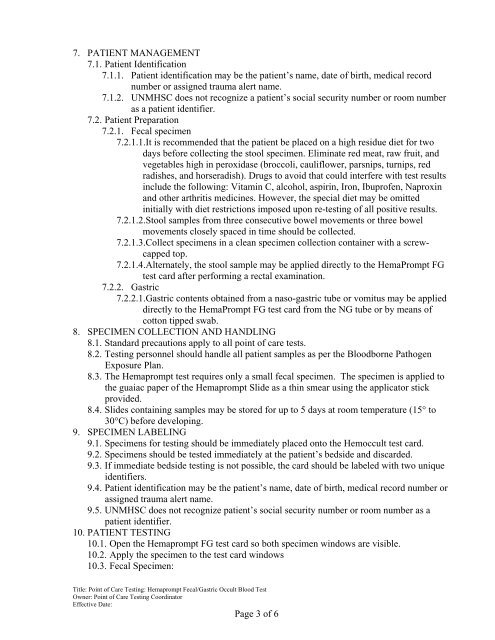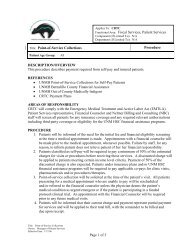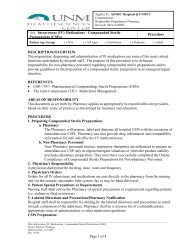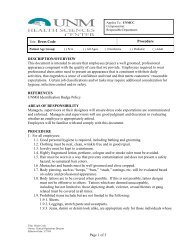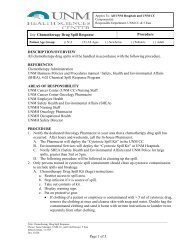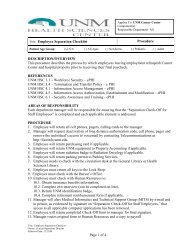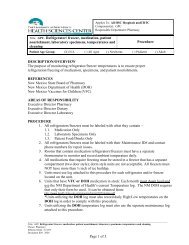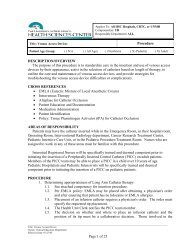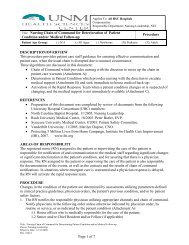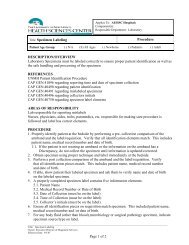Page 1 of 6 DESCRIPTION/OVERVIEW 1. PRINCIPLE 1.1. The ...
Page 1 of 6 DESCRIPTION/OVERVIEW 1. PRINCIPLE 1.1. The ...
Page 1 of 6 DESCRIPTION/OVERVIEW 1. PRINCIPLE 1.1. The ...
Create successful ePaper yourself
Turn your PDF publications into a flip-book with our unique Google optimized e-Paper software.
7. PATIENT MANAGEMENT7.<strong>1.</strong> Patient Identification7.<strong>1.</strong><strong>1.</strong> Patient identification may be the patient’s name, date <strong>of</strong> birth, medical recordnumber or assigned trauma alert name.7.<strong>1.</strong>2. UNMHSC does not recognize a patient’s social security number or room numberas a patient identifier.7.2. Patient Preparation7.2.<strong>1.</strong> Fecal specimen7.2.<strong>1.</strong><strong>1.</strong>It is recommended that the patient be placed on a high residue diet for twodays before collecting the stool specimen. Eliminate red meat, raw fruit, andvegetables high in peroxidase (broccoli, cauliflower, parsnips, turnips, redradishes, and horseradish). Drugs to avoid that could interfere with test resultsinclude the following: Vitamin C, alcohol, aspirin, Iron, Ibupr<strong>of</strong>en, Naproxinand other arthritis medicines. However, the special diet may be omittedinitially with diet restrictions imposed upon re-testing <strong>of</strong> all positive results.7.2.<strong>1.</strong>2.Stool samples from three consecutive bowel movements or three bowelmovements closely spaced in time should be collected.7.2.<strong>1.</strong>3.Collect specimens in a clean specimen collection container with a screwcappedtop.7.2.<strong>1.</strong>4.Alternately, the stool sample may be applied directly to the HemaPrompt FGtest card after performing a rectal examination.7.2.2. Gastric7.2.2.<strong>1.</strong>Gastric contents obtained from a naso-gastric tube or vomitus may be applieddirectly to the HemaPrompt FG test card from the NG tube or by means <strong>of</strong>cotton tipped swab.8. SPECIMEN COLLECTION AND HANDLING8.<strong>1.</strong> Standard precautions apply to all point <strong>of</strong> care tests.8.2. Testing personnel should handle all patient samples as per the Bloodborne PathogenExposure Plan.8.3. <strong>The</strong> Hemaprompt test requires only a small fecal specimen. <strong>The</strong> specimen is applied tothe guaiac paper <strong>of</strong> the Hemaprompt Slide as a thin smear using the applicator stickprovided.8.4. Slides containing samples may be stored for up to 5 days at room temperature (15° to30°C) before developing.9. SPECIMEN LABELING9.<strong>1.</strong> Specimens for testing should be immediately placed onto the Hemoccult test card.9.2. Specimens should be tested immediately at the patient’s bedside and discarded.9.3. If immediate bedside testing is not possible, the card should be labeled with two uniqueidentifiers.9.4. Patient identification may be the patient’s name, date <strong>of</strong> birth, medical record number orassigned trauma alert name.9.5. UNMHSC does not recognize patient’s social security number or room number as apatient identifier.10. PATIENT TESTING10.<strong>1.</strong> Open the Hemaprompt FG test card so both specimen windows are visible.10.2. Apply the specimen to the test card windows10.3. Fecal Specimen:Title: Point <strong>of</strong> Care Testing: Hemaprompt Fecal/Gastric Occult Blood TestOwner: Point <strong>of</strong> Care Testing CoordinatorEffective Date:<strong>Page</strong> 3 <strong>of</strong> 6


